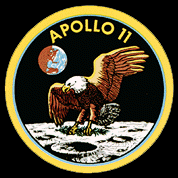

![]()
From Nasa Archives
At 6000 feet above the Moon's surface, a yellow caution light comes on...
In the Astronauts' own words
COLLINS: At five minutes into the burn, when I am nearly directly overhead, Eagle voices its first concern. "Program Alarm," barks Neil, "It's a 1202." What the hell is that? I don't have the alarm numbers memorized for my own computer, much less for the LM's. I jerk out my own checklist and start thumbing through it, but before I can find 1202, Houston says, "Roger, we're GO on that alarm." No problem, in other words. My checklist says 1202 is an "executive overflow," meaning simply that the computer has been called upon to do too many things at once and is forced to postpone some of them. A little farther along, at just three thousand feet above the surface, the computer flashes 1201, another overflow condition, and again the ground is superquick to respond with reassurances.
ALDRIN: Back in Houston, not to mention on board the Eagle, hearts shot up into throats while we waited to learn what would happen. We had received two of the caution lights when Steve Bales, the flight controller responsible for LM computer activity, told us to proceed, through Charlie Duke, the capsule communicator. We received three or four more warnings but kept on going. When Mike, Neil, and I were presented with Medals of Freedom by President Nixon, Steve also received one. He certainly deserved it, because without him we might not have landed.
ARMSTRONG: In the final phases of the descent after a number of program alarms, we looked at the landing area and found a very large crater. This is the area we decided we would not go into; we extended the range downrange. The exhaust dust was kicked up by the engine and this caused some concern in that it degraded our ability to determine not only our altitude in the final phases but also our translational velocities over the ground. It's quite important not to stub your toe during the final phases of touchdown.
From the Space-to-Ground audio tapes:
EAGLE: 540 feet, down at 30 [feet per second]...down at 15...400 feet down at 9...forward...350 feet, down at 4...300 feet, down 3 1/2...47 forward...1 1/2 down...13 forward...11 forward? coming down nicely...200 feet, 4 1/2 down...5 1/2 down...5 percent...75 feet...6 forward...lights on...down 2 1/2...40 feet? down 2 1/2, kicking up some dust...30 feet, 2 1/2 down...faint shadow...4 forward...4 forward...drifting to right a little...O.K....
HOUSTON: 30 seconds [fuel remaining].
EAGLE: Contact light! O.K., engine stop...descent engine command override off...
HOUSTON: We copy you down, Eagle.
EAGLE: Houston, Tranquility Base here. The Eagle has landed!
HOUSTON: Roger, Tranquility. We copy you on the ground. You've got a bunch of guys about to turn blue. We're breathing again. Thanks a lot.
TRANQUILITY: Thank you...That may have seemed like a very long final phase. The auto targeting was taking us right into a football-field-sized crater, with a large number of big boulders and rocks for about one or two crater-diameters around it, and it required flying manually over the rock field to find a reasonably good area.
HOUSTON: Roger, we copy. It was beautiful from here, Tranquility. Over.
TRANQUILITY: We'll get to the details of what's around here, but it looks like a collection of just about every variety of shape, angularity, granularity, about every variety of rock you could find.
HOUSTON: Roger, Tranquility. Be advised there's lots of smiling faces in this room, and all over the world.
TRANQUILITY: There are two of them up here.
COLUMBIA: And don't forget one in the command module.